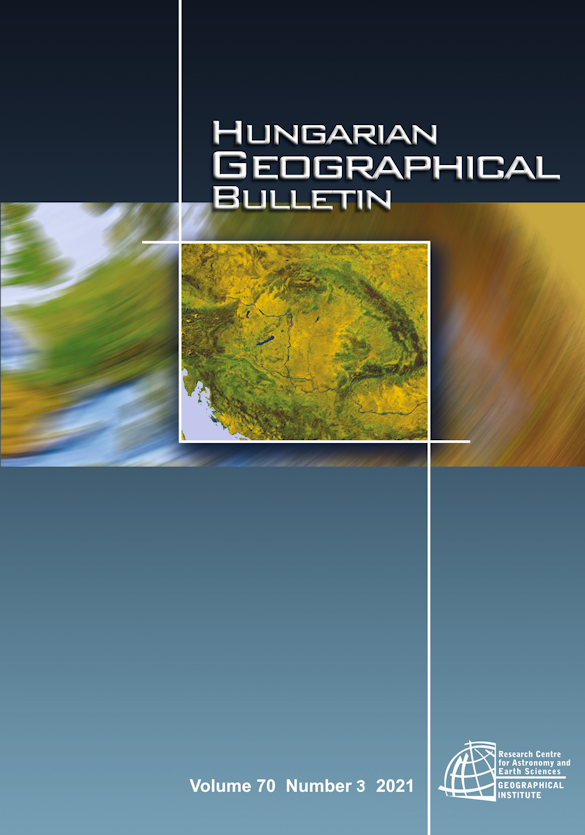Inspecting map compilation in earth sciences for better communication
Abstract
The use of thematic cartography in earth sciences is a frequent task for researchers when publishing. When creating a map, researchers intend to communicate important spatial information that enhances, supplements or replaces textual content. Not only visual but substantial requirements exist for those who create maps. Cartographic visualisation has several well-established rules that must be taken into account during compilation, but not all researchers apply them correctly. The present study aims to identify the factors determining the quality of geoscientific maps and what needs to be improved during a map compilation process. To get to know the tendencies, we have investigated maps in designated journals – one Hungarian and one international per earth science branch: geography, cartography, geology, geophysics, and meteorology. A system of criteria was set up for evaluating the maps objectively; basic rules of cartography, quality of visual representation, and copyright rules were investigated. The results show that better map quality is connected to journals with strict editorial rules and higher impact factors. This assessment method is suitable for analysing any kind of spatial visual representation, and individual map-composing authors can use it for evaluating their maps before submission and publication.
References
Albert, G., Virág, M. and Erőss, A. 2015. Karst porosity estimations from archive cave surveys-studies in the Buda Thermal Karst System (Hungary), International Journal of Speleology 44. (2): 151-165. https://doi.org/10.5038/1827-806X.44.2.5
Albert, G., Ilyés, V., Szigeti, C., Kis, D. and Várkonyi, D. 2017. How hard is it to design maps for beginners, intermediates and experts? In Advances in Cartography and GIScience. Lecture Notes in Geoinformation and Cartography. ICACI 2017. Ed.: Peterson, M., Cham, Springer. https://doi.org/10.1007/978-3-319-57336-6_17
Albert, G. 2018. 3D geológiai modellek fejlesztése térinformatikai szemlélettel (3D geological modelling from the aspect of GIS). Beau Bassin, GlobeEdit.
DiBiase, D. 1990. Visualization in the earth sciences. Earth and Mineral Sciences 59. (2): 13-18.
DiBiase, D., MacEachren A.M. and Krygier, J. 1992. Animation and the role of map design in scientific visualization. Cartography and Geographic Information Science 19. (4): 201-214. https://doi.org/10.1559/152304092783721295
DiBiase, D., Reeves, C., MacEachren, A.M., von Wyss, M., Krygier, J.B., Sloan, J.L. and Detweiler, M.C. 1994. Multivariate display of geographic data: Applications in earth system science. In Visualization in Modern Cartography. Eds.: MacEachren, A.M. and Taylor, D.R.F., Elsevier Publisher, 287-305. https://doi.org/10.1016/B978-0-08-042415-6.50022-3
Hodge, D.R. and Lacasse, J.R. 2011. Evaluating journal quality: Is the H-index a better measure than impact factors? Research on Social Work Practice 21. (2): 222-230. https://doi.org/10.1177/1049731510369141
Klinghammer, I. and Papp-Váry, Á. 1983. Földünk Tükre a Térkép (The Map, Mirror of the Earth).Budapest, Gondolat.
Kraak, M-J. 2002. Geovisualization illustrated. ISPRS Journal of Photogrammetry & Remote Sensing 57. 390-399. https://doi.org/10.1016/S0924-2716(02)00167-3
Kraak, M-J. and Ormeling, F. 2010. Geographical information science and maps. In Cartography: Visualization of Geospatial Data. Third edition. Eds.: Kraak, M-J. and Ormeling, F., Essex, England. Pearson Education Limited, 1-19. https://doi.org/10.1201/9780429464195-1
MacEachren, A.M. 1994. Visualization in modern cartography: Setting the agenda. In Visualization in Modern Cartography. Eds.: MacEachren, A.M. and Taylor, D.R.F., Elsevier Publisher, 1-11. https://doi.org/10.1016/B978-0-08-042415-6.50008-9
MacEachren, A.M. and Ganter, J.H. 1990. A pattern identification approach to cartographic visualization. Cartographica 27. (2): 64-81. https://doi.org/10.3138/M226-1337-2387-3007
Philbrick, A.K. 1953. Toward a unity of cartographical forms and geographical content. Professional Geographer 5. (5): 11-15. https://doi.org/10.1111/j.0033-0124.1953.55_11.x
Robinson, A.H., Morrison, J.L., Muehrcke, P.C., Kimerling, A.J. and Guptill S.C. 1995. Elements of Cartography. NewYork, John Wiley & Sons.
SCImago Journal & Country Rank 2020. Available at https://www.scimagojr.com/
Szigeti, Cs., Albert, G. and Kis, D. 2018. Measuring the map readers interpretation of hypsography. In 7th International Conference on Cartography & GIS. 18-23. June 2018. Sozopol, Bulgaria. Proceedings. Eds.: Bandrova, T. and Konečný, M., Sofia, ICA Publication, 547-555.
Copyright (c) 2021 Márton Pál, Gáspár Albert

This work is licensed under a Creative Commons Attribution-NonCommercial-NoDerivatives 4.0 International License.






